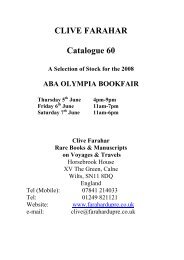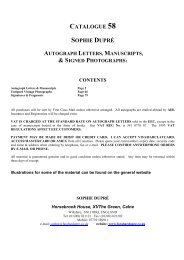Create successful ePaper yourself
Turn your PDF publications into a flip-book with our unique Google optimized e-Paper software.
55 AUTOGRAPH LETTERS,MANUSCRIPTS &SIGNED PHOTOS<br />
395. TOMBS (Sir Henry, 1824-1874, V.C. in the Indian<br />
Mutiny, General)<br />
ALS to‘My dear Mackenzie’, saying he would have helped<br />
but that “the appts. to Shoebury do not in the least depend<br />
on interest but on the exigencies of the Service - thus if<br />
you can be spared from your Brigade, if there are not<br />
already too many officers of that Bde. away at Shoebury or<br />
elsewhere ... you will have no difficulty ... Your ... only way<br />
is to go to the Dy.A.G.’s Office at the Horse Guards and see<br />
Col. Middleton or Col. Traill”, and hoping “you are<br />
enjoying your visit to England after the tropical China you<br />
have been in so long”, 3 sides 8vo., Dolgelly, N. Wales, 4th<br />
July n.y., c. 1860 [SD50101]£175<br />
396. TYRRELL (Sir William G., 1858-1968, Head of<br />
Political Intelligence at the Foreign Office during WWI,<br />
Ambassador to France 1928-1934) and his deputy<br />
MONTGOMERY (Sir Charles Hubert, 1876-1942)<br />
Remarkable Group of 10 ALS, 1 telegram, and 16 TLS to<br />
Dr Ferdinand L. Leipnik, 1869-c.1924, the Hungarian<br />
Journalist and Connoisseur, most of the TLS bear their<br />
Foreign Office file numbers, they concern Leipnik’s help<br />
while in neutral Holland in procuring enemy diplomatic<br />
papers ,gauging public opinion in the Austro-Hungarian<br />
dominions, relaying enemy overtures for peace ,and<br />
making suggestions for propaganda, the letters contain<br />
telling insights as to the possibility of a democratic<br />
revolution in Germany ,andon Germany’s economic<br />
hold on her allies ,theycan be related to and shed light on<br />
the letters sent by Leipnik now at the Public Record<br />
Office ,and show how Leipnik and Tyrrell established their<br />
rapport, together 44 sides, Foreign Office, London, 1st July<br />
1912 - 1921 some neat filing holes [SD19040]£775<br />
Tyrrell writes “A summary of Hungarian and Croatian press news<br />
would be much appreciated here” (14th July 1916), also particular<br />
books by Andrassy and Tisza, and “any copies of official<br />
diplomatic correspondence issued by the Austrian, Russian,<br />
Roumanian, or Serbian Governments at any time between 1900<br />
and 1914 ... we have all those issued since the war began” (18th<br />
September 1916), Leipnik has been talking with Louis P. Lochner<br />
[General Secretary, Neutral Conference for Continuous<br />
Mediation], Tyrrell agrees with Leipnik’s explanation to Lochner<br />
of Henry Ford’s peace scheme so far (12th October 1916), “the<br />
official [Austrian] correspondence is just what [our people] have<br />
been trying to get for some months” (23rd October 1916, second<br />
letter), Leipnik has proposed a conference for the “reconstruction<br />
of International Law” but “H.M. Government” could not<br />
countenance one (4th December 1916, [Lord Grey said this was<br />
for neutrals so long as the war lasted]), Leipnik returns from the<br />
U.S.A. via the U.K. [by special permit as an enemy alien, see FO<br />
papers] and Tyrrell asks him “if you have nothing better to do to<br />
lunch at the St. James’s Club tomorrow” (8th February 1917), he<br />
asks for “names of some neutral writers” to write in the “English<br />
papers” (12th July 1917), “Germany is the last country at present<br />
to indulge in a democratic revolution ... The Junkers like the<br />
Bourbons of old are alone capable of provoking a revolution;<br />
there does seem an off chance of Hindenberg & Ludendorff<br />
bringing that off, if given enough rope ... It is almost a physical<br />
impossibility for [Austria-Hungary] to emancipate herself from the<br />
German yoke. Please do write again” (23rd July 1917), Germany<br />
will not allow Austria the “increased prestige” of concluding a<br />
separate peace, nor contemplate it herself “until she has securely<br />
fettered her allies economically”, he agrees “Kuhlmann [German<br />
Foreign Minister, whom Leipnik met in The Hague] is sincere”<br />
but the “surface moderation” of his terms may be “deceptive on<br />
examination” (15th September 1917). The correspondence<br />
continues after the war about the Paris Peace conference and the<br />
League of Nations, “as regards Pesth ... I feel sure you could do<br />
good among those people who want above all good advice and<br />
prompting” (14th August 1919, during Béla Kun’s communist<br />
interregnum, swept away by Admiral Horthy in November 1919),<br />
“I shall be only too pleased if I can help to explode sane<br />
[“forsooth”] the ex-Emperor’s fiction” (4th October 1922,<br />
referring to Charles of Austria-Hungary, 1887-1922, reigned<br />
1916-1918).<br />
For the interlocking papers at the PRO, see the headings in the FO<br />
Card Index of Correspondence, 1914-1919, under ‘Leipnik’, and<br />
especially class FO371. On 6th October 1917 the British<br />
Ambassador at The Hague wrote asking for instructions, the<br />
Austrian Minister had asked Leipnik to find out “if, in the event of<br />
his happening to meet me at Leipnik’s house [in Scheveningen], I<br />
would report to you any conversation that might ensue”,<br />
mentioning some possible territorial changes as peace terms,<br />
adding “I should be in a position to give an immediate ‘Yes’ or<br />
‘No’ without appearing to have received instructions” (File<br />
134202 f 58).<br />
Before the war Leipnik was editor of the ‘Pester Lloyd’, but<br />
resigned in 1911. He first contacted Tyrrell in 1912. He was in<br />
London when war broke out, and tried to get a Home Office pass<br />
as afriendly enemy alien (see Tyrrell’s telegram, 23rd October<br />
1914), with a view to naturalization after four years’ residence,<br />
but this never happened.<br />
MBERTO II (1904-1989, Duke of Savoy, King of<br />
Italy)<br />
Excellent portrait photo by Alfredo Pesce, Napoli,<br />
signed “Umberto di Savoia” and inscribed to<br />
“Maggiore Francesco Faraore”, showing him head and<br />
shoulders in uniform, wearing many medals and<br />
decorations, 10” x 7½”, in mount 15” x 11” n.p. (Naples),<br />
1935, framed and glazed [SD21345]£325<br />
ICTOR EMMANUEL III (1869-1947, King of<br />
Italy, Abdicated 1946 in favour of his son<br />
Umberto) & his son UMBERTO II (1904-1989,<br />
Duke of Savoy, King of Italy)<br />
Fine pair of e xcellent reproduction oval portraits,<br />
Umberto’s by Massagli, Turin, both signed and dated,<br />
showing them both head and shoulders in uniform, wearing<br />
many medals and decorations, 11” x 13”, overall 18” x 13”<br />
n.p. 1921 & 1926 [SD26412]£575<br />
399. VIEUXTEMPS (Henri, 1820-1881, Belgian<br />
Violinist and Composer)<br />
ALS to ‘Dear Sir’, in English, apologising that he had<br />
found it “utterly impossible to answer not knowing myself,<br />
how business would turn”, but that he will now “remain<br />
here till 24th July”, and can start lessons from 1st April<br />
“what days you please”, to help “perfection such a<br />
promising talent”, 1 side 8vo., 4 Maddox Street, Regent<br />
Street, 23rd March 1846 [SD50023]£125<br />
Vieuxtemps had just accepted the post of solo violinist to the<br />
Tsar, 1846-1852, and professor at St. Petersburg. His staccato<br />
was famous all over the world, and his tone exceptionally rich and<br />
full.





